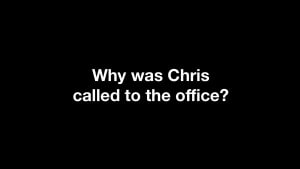Every 7 seconds.
That’s how quickly things change on television shows.
Scenes change, camera angles change, a character walks out, a character walks in.
The next time you’re watching TV, pay attention and you’ll see.
Almost every 7 seconds, something will change.
No wonder your students get bored and distracted when you speak.
When you speak for 15, 20, or maybe even 30 minutes, your students get distracted. Is it any wonder why? How much movement do you include? Students consume media that switches things up every 7 seconds. They’re distracted because they’re bored. And they’re bored because nothing is changing visually.
Sure, there are a few things you can do:
If you have a stool, you could stand up for a few minutes and then sit back down. If you’re in tune with your voice tone and speaking pace, you could vary them up a bit.
But those things aren’t enough to keep your students engaged.
Is there anything else you can do?
Yes. You can use more slides.
Most youth pastors don’t use enough slides.
I’ve coached dozens of youth pastors and observed hundreds of youth ministry programs. I can say with confidence that most youth pastors don’t use enough slides during their sermons.
Here’s the typical scene that I see when a youth pastor gets up to speak:
1. Message bumper plays
2. Youth Pastor starts to speak with a message title slide or series cover art on the screen.
3. After 8 minutes, the same slide is still on the screen and they’re finishing their introduction.
4. Youth Pastor mentions the Bible verses that they plan to cover. The slide with the verses has way too much text (instead of using 2 or 3 different slides they shrunk the font and put everything on 1 slide), weird spacing, and usually includes a typo or grammatical error.
5. Youth Pastor talks for another 10 minutes while that slide is on the screen. If there’s another verse that is referenced, perhaps it will have its own slide. But that’s not always the case. Sometimes the Youth Pastor will mention random verses that lack corresponding slides for students to follow along. The Youth Pastor feels like the message is moving along. To a student, however, it feels like the message is standing still.
6. Students start to yawn. Or text the person next to them. Or check Instagram and Snapchat.
7. Youth Pastor is ready to wrap it up. A new slide pops up. It’s the Bottom Line, the Tweetable statement of the message. Except there’s a problem: it’s not tweetable (a tweet is limited to 140 characters, not 3 sentences), it’s not memorable, and it’s not actionable.
8. Youth Pastor prays, concludes the program, and tells the students to do a better job inviting their friends to come with them next week.
How does that compare with your last sermon?
How about this one…
Contrast that scene with these slides I used during a story in a recent message:
I had a friend in middle school named Chris.

He was a friendly guy. Normal, average as far as middle schoolers go. He wasn’t Mr. Popular, but he wasn’t an outcast either. He was my friend.
Well, one day the announcement speaker turned on in our classroom.

“Mrs. Nettles?”
“Yes?”
“Would you please send Chris to the office?”
“I sure will.”
And all of us wondered what Chris had done to get called to the office.

It could be bad:
Maybe he’d cheated on his homework.
Maybe he got caught smoking something in the bathroom.
Maybe he was bullying another student.
Any of those things could get you called to the principal’s office, for sure. But Chris was a nice, normal, average student. He wasn’t rebellious. He wasn’t a trouble-maker. So those things weren’t likely.
Maybe it was a good thing. How about a show of hands? How many of you like art class?

Chris enjoyed art, and he was pretty good at drawing. Maybe he was being called to the office to win an award for one his drawings. That would be cool, huh? Well, Chris got up, left the classroom, and took the long walk to the office. Why was Chris called to office?

Here’s what happened:
When he got there, his mom was waiting for him.
She had clearly been crying. She was very upset.
Something was definitely wrong.
“What’s wrong mom?”
“There’s been a bad car accident.”

“Is everyone okay?”
“Sweetie. Your dad was in it. He’s not coming home. I need you to be strong because you’re the man of the house now.”

Chris’ dad had died.
Chris had to step up and take on more responsibilities than he was ready to handle.
Do you see the difference?
I’m sure you do. That’s a lot of slides for a 4-minute story, right?
Guess how many students were yawning.
Zero.
Guess how many students were texting.
Zero.
Guess how many students were talking.
Zero.
Your students are visual people. Images help them see what you’re talking about. Images communicate to them in ways that words alone can’t.
Why would merely tell them when you can show them?
EPIC Preaching
It’s been several years since Len Sweet began advocating for an EPIC style of preaching: Experiential, Participatory, Image-Rich, and Connective.
He writes, “Pulpit-centric preachers learned how to exegete words. But EPIC preaching delivers the passion of images” (The Gospel According to Starbucks, 113).
He is the one who originally taught me to load my slides with as many images as I could. Honestly, it’s been one of the most helpful ideas I’ve picked up for preaching, especially to students.
The 200-Slide Solution
Seth Godin is a provocative marketing guru who proposed The 200 Slide Solution. On his blog, he wrote, “The next time you find yourself on the hook for a 40-minute presentation (with slides!) consider, at least for a moment, a radical idea: A slide every 12 seconds. 200 slides in all… Slides create action.”
He gets it. Slides engage your audience and propel them forward. The more, the better. The fewer, the worse.
Your Move
Here’s what I want you to do:
Write your next message. Then go through that message and highlight every word, phrase, scene, and emotion that you could possibly represent with an image.
Next, type the word into Google and search through images. This simple search will give you thousands of images to choose from.
All you have to do is drag the image straight into your Powerpoint slide.
When you do that, your next sermon will come alive for your students.
I can do this for you.
If all of this feels like too much work or you think you don’t know how to do it, I can do it for you. In the Resource Store, I offer Done-for-You Sermon Slides. You send me your sermon and I create the slides. Check it out if you’re interested.
Once you see how it’s done, you’ll be designing your own slides and delivering messages that keep your students more engaged than they’ve ever been before!
Latest posts by Trevor Hamaker (see all)
- 7 Ways to Deal with Disruptive Students - December 18, 2024
- Fighting Frustration by Shifting Your Focus - December 18, 2024
- What is the Most Important Job of a Small Group Leader? - December 18, 2024
Did You Like This Post?
Sign up to get updates sent to your inbox each week!
You're in! Want more ideas and support for your ministry? Check out the BYM Community!
http://bit.ly/bymcommunity


2 thoughts on “Why I Use 30 Slides in a 15-Minute Sermon (and You Should Too)”
Ahhhh I love this so much. I am a new youth pastor at a church that hasn’t had a weekly youth group and so I am starting one up soon and I plan on using this technique with my youth sermons. I have always been told to try to keep them shorter, move around, use voice inflection, and things like that. The idea of using slides at this rate is phenomenal and I am excited to see the results.
Derek,
I’m glad you like this post. All of the things you mentioned are good to incorporate in your sermons, but I really think including more slides will help tremendously.
Let me know if I can help you with ideas as you start your new group. I’ve been there before.
It’s an exciting time!
Comments are closed.